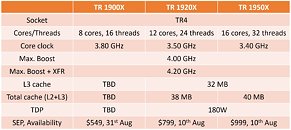Wednesday, August 2nd 2017

AMD Ryzen Threadripper TDP and Cache Sizes Confirmed
AMD maybe have shaken up the HEDT (high-end desktop) processor market with three Ryzen Threadripper SKU announcements early this week; but the two specifications that eluded us were their rated TDP and cache amounts. The first Ryzen Threadripper models will be available in the market from the 10th of August, and will include the 12-core/24-thread 1920X and the flagship 16-core/32-thread 1950X. Both models will feature the full 32 MB of L3 cache available from a pair of 14 nm "Summit Ridge" dies, which work out to "total cache" (L2+L3) amounts of 38 MB for the 1920X and 40 MB for the 1950X. The TDP of the 1920X and 1950X is rated at 180W. The TDP and cache configuration of the 8-core/16-thread 1900X remains unknown, for now.
Source:
VideoCardz

22 Comments on AMD Ryzen Threadripper TDP and Cache Sizes Confirmed
review of the 16core will be seen in a matter of a week :D
but these clocks are crazy for a 16core, and the infinity fabric designs rock :)
But the infinity fabric is supposed to be the Aquilles heel of the Zen architecture ...
Achilles' heel is too strong, it's a bottleneck that can be observed under some scenarios and that is completely irrelevant in many others.
Unless some new materials replace silicon, we'll soon be @ the limit and the only way is to improve core count, but that gets very very expensive with higher number of cores due to low yields. AMD realized this and came up with infinity fabric which solves the low yields problem because Zen chips are small enough to have very high yields, thus making high core count chips not only possible for a "cheap" price but also very scalable.
Remember: the same Zen chip is the main component of Ryzen / Threadripper offerings from 4 C / 4 T all the way to 32 C / 64 T, made possible by infinity fabric.
And yes, your sarcasm font wasn't very readable to me ;)
IF is not a magic bullet, as you call it, but it can delay the limit of what process shrinking + high core count can achieve. I wouldn't be surprised if we could have a 64 C / 128 T chip in like 5 years or so by using 7 nm FinFet (or smaller) as well as infinity fabric 2.0, or something along those lines. Making a silicon chip like that but monolithic should be impossible.